36 Different Types Of Fruit Trees To Plant In Your Yard (With Pictures)
When it comes to adding a delicious and nutritious touch to your outdoor space, planting fruit trees is an excellent option. With numerous varieties to choose from, selecting the right one can be overwhelming. In this article, we’ll explore the best types of fruit trees to plant in your yard based on your specific needs and preferences, as well as provide valuable tips on how to care for them so you can enjoy their fruits for years to come.
For those who are new to growing fruit trees, it’s essential to understand what they are and where they originated from. We’ll also delve into the different categories of fruit trees, including pome fruits and stone fruits, before diving into a comprehensive list of popular varieties. Whether you’re looking for something sweet or tart, there’s a fruit tree out there that’s perfect for your yard.
Some of the most popular types of fruit trees include almond, apple, apricot, avocado, carambola, cashew, cherry, coconut, durian, fig, grapefruit, guava, Indian gooseberry, jaboticaba, jackfruit, kumquat, lemon, lime, lychee, mango, mulberry, olive, orange, papaya, peach, pear, pecan, persimmon, plum, pomegranate, pomelo, quince, rambutan, sapodilla, soursop, and sweet chestnut.
What are fruit trees?
Fruit trees are a class of deciduous or evergreen plants that yield edible fruits. The majority of fruit trees are characterized by their juicy and sweet products, with popular varieties including apple, cherry, peach, and plum trees. Interestingly, some fruit trees also bear nuts, such as almond and walnut trees, which are highly valued for their nutritional properties.
History of fruit trees.
For thousands of years, fruit trees have been a cornerstone of human culture, with their history as complex and vibrant as the fruit they produce. The earliest recorded evidence of fruit tree cultivation dates back over 4000 years to ancient China, where these versatile plants were valued for both their edible fruits and ornamental flowers. As civilizations rose and fell, fruit trees spread throughout the Mediterranean region, becoming a staple in ancient Egyptian and Greek societies.
In Rome, they were even more ubiquitous, often planted in home courtyards and public spaces. When European settlers arrived in the New World, they brought apple trees with them, which quickly became an integral part of American landscapes. Today, fruit trees are cultivated globally, bringing joy and sustenance to people from all walks of life.
Pome Fruits.
Pome fruits, which include apples, pears, and quinces, boast a unique characteristic – they contain seeds surrounded by a fleshy core. The most prominent types of pome fruits are apples and pears, with over 7,000 and 3,000 varieties respectively. Quinces, on the other hand, are relatively rare, with only a few hundred varieties grown worldwide. These fruits are not only delicious but also nutritious, offering a rich source of fiber, vitamins, and minerals while being low in calories and fat.
Enjoy them fresh, canned, or dried – pome fruits make for a versatile and healthy addition to any diet.
Stone Fruits.
Stone fruits, characterized by their pit or stone in the center, encompass a diverse range of varieties such as cherries, plums, apricots, and peaches. Interestingly, this central stone is actually the seed of the fruit itself. Beyond their unique composition, stone fruits are notable for their richness in vitamins, minerals, and fiber. As a result, they can be enjoyed fresh, preserved through canning, or dried to make them more accessible throughout the year.
Types of Fruit Trees.
With an array of options available, selecting the perfect fruit tree can be a daunting task. From the classic apple and orange trees to more exotic varieties like bananas, each type has its unique characteristics and advantages. Before making a decision, it’s essential to consider the pros and cons of each option. Here are some of the most well-known types of fruit trees that you might want to explore:
Almond tree.

Within the realm of deciduous trees, the almond tree stands out as a member of the Rosaceae family, hailing from the Mediterranean region. Interestingly, the term ‘almond’ also refers to the edible seed produced by this tree. Within the Prunus genus, it’s classified alongside the peach in the subgenus Amygdalus, distinguished by corrugations on the shell surrounding the seed. The fruit of the almond takes the form of a drupe, comprising an outer hull and a hard shell containing the seed within.
Shelling almonds involves removing the shell to reveal the kernel or ‘meat’ inside. Almonds are commonly sold either shelled or unshelled. Blanched almonds, on the other hand, are shelled almonds that have been treated with hot water to soften the seedcoat, allowing for its subsequent removal and revelation of the white embryo.
The almond’s origins can be traced back to Iran and surrounding regions, yet it has been cultivated since ancient times throughout the Mediterranean region, extending into Europe, Asia, and North Africa.
Apple trees.

Apple trees, a type of fruit tree renowned for producing juicy apples, typically thrive in temperate climates where they can reach impressive heights of up to 30 feet. To flourish, apple trees require bountiful sunlight and well-drained soil. Despite their relatively long lifespan, with proper care, these trees can live for over 100 years, offering a bounty of delicious fruit for generations to come.
Apricot Trees.

Apricot trees, belonging to the rose family and native to China, have become widespread across the globe. These deciduous fruit trees are renowned for their delectable fruits, which are frequently used in sweet treats like pies, jams, and desserts. However, apricot trees demand meticulous care and attention. Pruning is crucial, and organic fertilization is essential to ensure optimal growth. Moreover, consistent watering is vital, as these trees thrive in moist environments.
If you reside in a region with strong winds, it’s advisable to stake your tree to prevent damage or uprooting.
Avocado trees.

Native to Mexico and Central America, the avocado tree is a member of the Lauraceae family, which also includes plants like cinnamon, camphor, and bay laurel. When it comes to propagation, some avocado varieties don’t produce true-to-type seedlings, making grafting a popular method for growers. For those living in frost-free climates, avocados can thrive as houseplants and be successfully container-grown at home.
While avocado trees are generally easy-going and low-maintenance, they do require specific conditions to produce a bountiful harvest of fruit. To achieve this, growers must meet certain needs and provide the right environment for their trees.
Carambola trees.

Natively found in the Indian subcontinent and Southeast Asia, Carambola trees boast a unique feature – their fruits have a tart and sweet taste, making them a popular choice for salads or as a garnish to elevate other dishes. While not demanding, these trees still require some attention to thrive. They do best when planted in areas that receive full sun and are well-drained, allowing the roots to breathe and absorb nutrients freely.
Interestingly, Carambola trees are naturally drought-tolerant and can withstand brief dry spells without compromising their health. However, regular watering does lead to a more bountiful harvest, as the fruits ripen with consistent moisture.
Cashew trees.
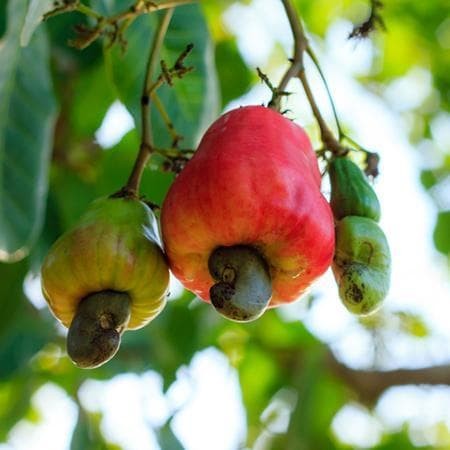
Cashew trees have spread globally from their native Brazil, with their unique fruit, the cashew apple, being a key feature. The seed contained within this fruit is what we commonly know as the cashew nut. These trees can reach impressive heights of up to 20 meters and have a lifespan of around 30-50 years.
While the cashew apple isn’t typically consumed raw due to its urushiol content, which can cause skin irritation in some individuals, it is still used to produce jams, jellies, and wines.
In contrast, the cashew nut is the most widely enjoyed part of the tree. It can be enjoyed raw, roasted, or ground into a powder, and is also utilized in the production of cashew butter and cheese.
Cashews are an excellent source of various essential vitamins and minerals, including zinc, iron, and magnesium. They’re also a good source of protein and fiber, making them a nutritious addition to any diet.
Cherry trees.
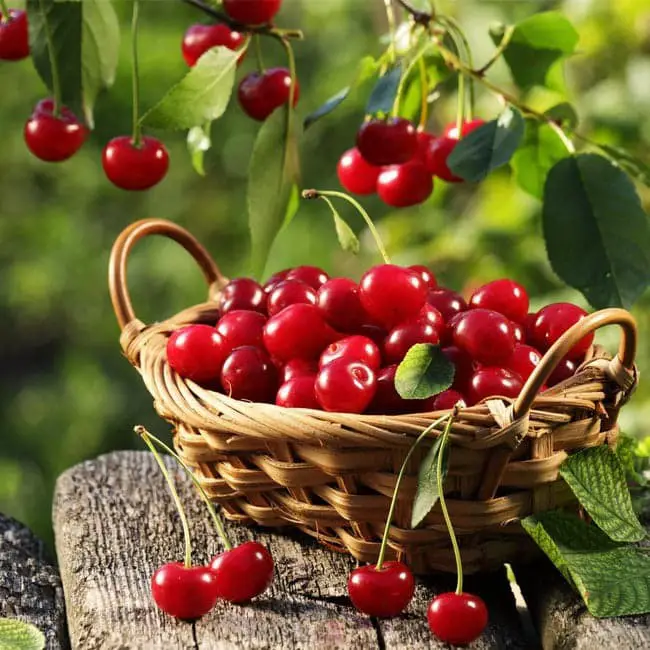
Native to Asia and the Americas, cherry trees boast a rich history of cultivation, not only for their succulent fruits but also as ornamental plants. The tree’s distinctive dark red or black cherries are just one notable feature – its wood is highly prized in furniture and cabinetry making, while its showy flowers and autumnal foliage make it a popular choice for landscaping purposes.
Coconut trees.

Coconut trees, a type of palm, thrive in tropical climates. Their slender trunks and large, circular leaves are distinct features that set them apart. These versatile trees can grow up to 30 feet tall and enjoy a lifespan of over 100 years.
As a vital source of sustenance and income, coconut trees play a crucial role in the lives of many people living in tropical countries.
The tree’s most notable product is the coconut fruit, which is used for consumption and in the production of oil, soap, and other commodities. Beyond providing food and economic opportunities, coconut trees also offer shelter from the elements, casting a cooling shade beneath their expansive canopies.
Durian trees.
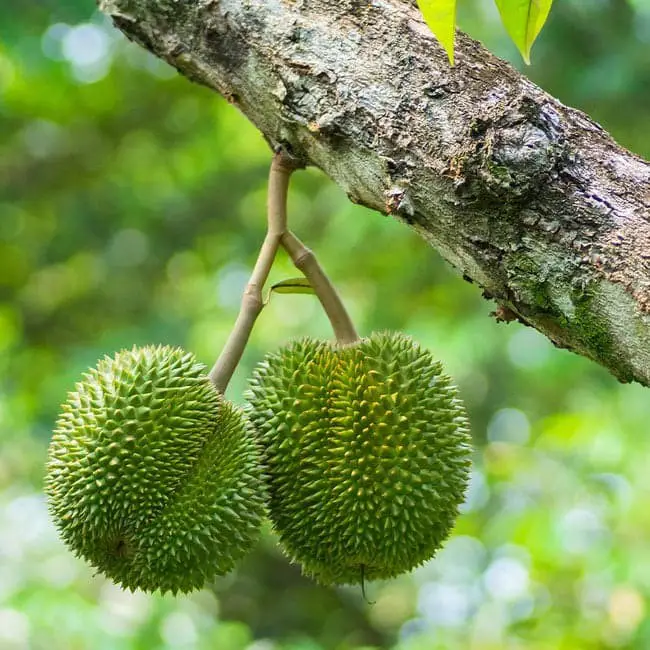
Durian trees are a tropical fruit tree species native to Southeast Asia, thriving in warm and humid climates. The fruit itself, known as durian, is renowned for its enormity and pungent aroma. As the fruit of these trees, it’s no surprise that durians have become a staple in Southeast Asian cuisine, often consumed fresh or incorporated into recipes. The mature durian tree can reach heights of approximately 30 meters (100 feet), with fruits capable of weighing up to two kilograms (four pounds).
Notably, the outer skin is thick and covered in spines, while the inner flesh is creamy white. The taste experience is overwhelmingly sweet, although the fruit’s potent aroma may be off-putting to some.
Fig trees.

Fig trees, a staple in many gardens, thrive in diverse climates – from the warmth of tropical regions to more temperate zones. Their adaptability is matched only by their ease of maintenance. With proper care, these trees can yield an abundant crop of luscious figs, making them a popular choice among gardeners and fruit enthusiasts alike.
Grapefruit trees.

Grapefruit trees, a type of citrus tree, are renowned for producing the large, round fruit known as grapefruits. Characterized by thick skin and juicy flesh, these fruits exhibit a tangy, slightly bitter taste profile. Native to Asia, grapefruit trees were introduced to Europe and North America in the 18th century. Today, they thrive in warm climates like Florida and California, where commercial cultivation is common.
As evergreen trees, grapefruits can grow up to 20 feet tall, boasting dark green leaves with sharp edges and a glossy appearance. In springtime, the tree produces white or pink flowers that add a touch of elegance to its surroundings. Grapefruit fruits typically ripen during winter months, making them a popular breakfast choice when enjoyed with yogurt or cereal.
Guava trees.

Guava trees, native to tropical America, thrive in numerous countries across the continent, including Brazil, Peru, Ecuador, Colombia, Venezuela, Puerto Rico, Cuba, Haiti, the Dominican Republic, and Mexico. This small evergreen tree can reach impressive heights of five to ten meters tall. Its leaves boast a characteristic dark green color with a leathery texture, providing a unique visual identity.
The flowers of the guava tree are delicate white blooms featuring five petals, while the fruit is often round or oval in shape and exhibits a vibrant palette of red, yellow, and green hues.
Indian Gooseberry trees.

Native to India, the Indian Gooseberry tree (Phyllanthus emblica) is a deciduous species that thrives both in its natural habitats within Indian forests and through cultivation across various regions. As a member of the Rutaceae family, this versatile plant can take on the form of a large shrub or small tree, reaching heights of up to 15 meters. Its leaves are characterized by their simplicity, featuring an alternate arrangement and an ovate shape with a blunt tip.
The flowers, which bloom in clusters, are delicate and white, providing a subtle yet attractive display. Perhaps most distinctive, however, is the fruit – a spherical berry that can range in color from yellow to green.
Jaboticaba fruit trees.
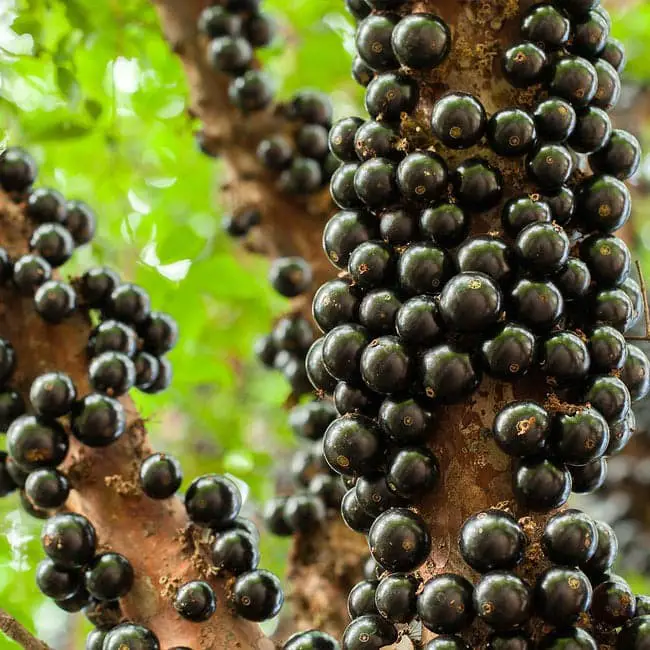
Jaboticaba, a native Brazilian tree, defies convention with its peculiar fruiting habit – small, round fruits grow on the trunk and branches rather than the ends of limbs. The flavor profile is reminiscent of a harmonious blend of grape and strawberry, with a hint of acidity. This unique characteristic sets Jaboticaba apart from other fruits. The tree itself is an ornamental delight, reaching heights of 20-25 feet with dark green leaves and gray-barked branches that exude smooth elegance.
As an evergreen, the Jaboticaba fruit tree offers a year-round display of lush foliage, punctuated by clusters of small white flowers that eventually give rise to fruits about the size of a grape. When ripe, these fruits turn a deep purple or black hue. The versatility of Jaboticaba fruit is undeniable – enjoy it fresh, use it in jams and jellies, or craft wine from its rich pulp.
Jackfruit trees.

Nestled within the tropical realms of South and Southeast Asia, the jackfruit tree has thrived for centuries. Its fruit, a behemoth of green flesh, can reach an astonishing weight of up to 80 pounds (36 kg), making it a truly impressive sight. As an added bonus, the tree yields a sweet, sticky juice that is often put to good use in crafting delectable desserts. The jackfruit tree’s ancestry lies with the Moraceae family, which also encompasses figs and mulberries, among other fruits.
According to legend, the tree first sprouted its roots in the lush rainforests of the Himalayas, where it has continued to flourish over time.
Kumquat trees.
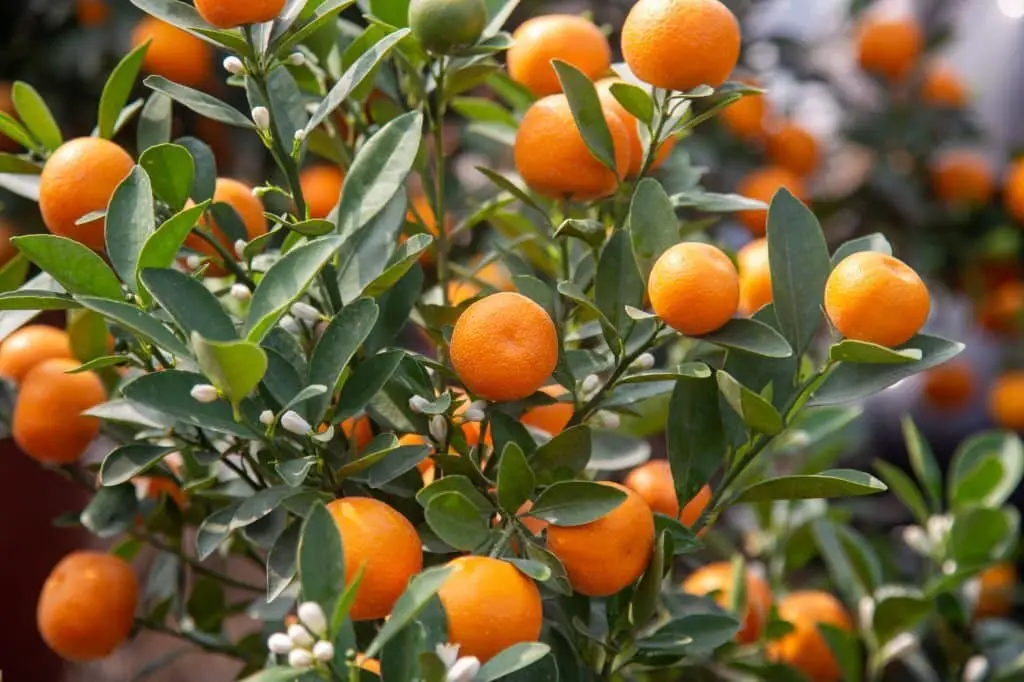
The kumquat tree, a small evergreen species, boasts a rich history of cultivation in China, dating back centuries. This diminutive tree grows to approximately 15 feet tall, with dark green, glossy leaves that provide an attractive canopy. The fruit itself is oval-shaped and sports a vibrant orange hue, boasting a tart flavor profile that lends itself well to uses in marmalades and jams.
With its widespread cultivation across Europe, Australia, and the United States, the kumquat tree has earned a spot as a global treasure.
Lemon trees.

Kumquat trees, a type of citrus tree, yield small, oval-shaped fruit with edible skin often used in candied form. This ancient species hails from Asia, where it has been cultivated for centuries in China and Japan. The kumquat’s global presence expanded when it was introduced to Europe in the 18th century and the United States in the 19th century. Today, its cultivation is widespread, with notable hotspots including Florida, California, and Israel.
Lime trees.
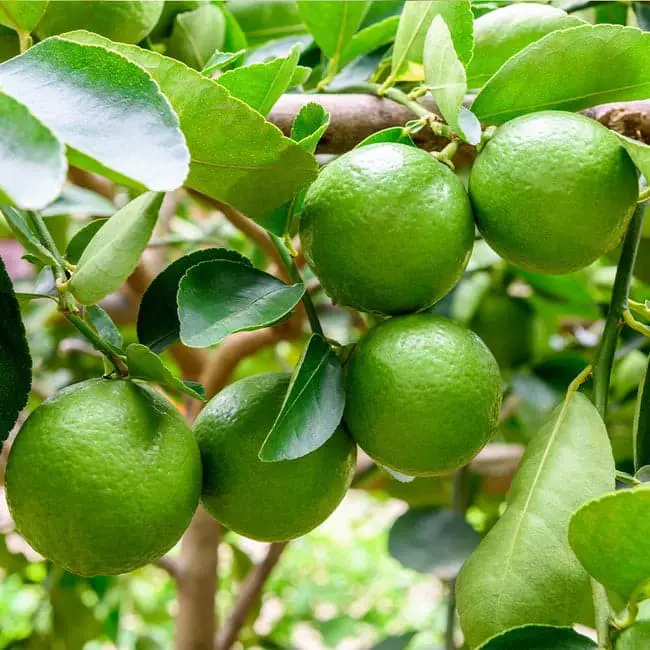
Lime trees belong to the citrus family, scientifically known as Citrus aurantifolia. Hailing from Asia and the Indian subcontinent, they have been cultivated extensively in warm climates worldwide. Their evergreen foliage and white blooms create a picturesque landscape, while their small, green citrus fruits add a burst of flavor and color. As a popular choice for landscaping in warm regions, lime trees are remarkably resilient, able to thrive in dry conditions and poor soil quality.
Moreover, they produce an abundance of fruit, making them an ideal selection for home gardens seeking a bountiful harvest.
Lychee trees.

Lychee trees, native to China, have been cultivated for over 2000 years. Today, they’re grown not only in their country of origin but also in many other parts of the world, including the United States. Standing tall at a height of 20-40 feet, these tropical fruit trees boast a short trunk and a dense canopy of leaves that are dark green and lance-shaped with a leathery texture. The tree’s small, white flowers grow in clusters, adding to its unique charm.
The lychee fruit itself is roughly the size of a large grape, featuring a thin red skin that’s easy to peel off. Beneath this exterior lies white flesh with a sweet, floral flavor profile. As a result, the fruit is often enjoyed fresh or used in sweet treats.
Mango trees.

Mango trees, scientifically known as Mangifera indica, thrive in warm climates and can reach remarkable heights of 30 to 40 meters (98 to 131 feet), making them a prominent feature in tropical regions. The fruit itself is characterized by its oblong or oval shape, with a range of colors including yellow, green, and red upon ripening. The sweet and juicy flesh is typically orange or yellow in hue, surrounded by a significant stone at the center.
As a staple food globally, mangoes are commonly consumed fresh, cooked, or transformed into refreshing juices. Interestingly, this versatile fruit has its origins in South Asia, but today, it can be found flourishing in many tropical regions worldwide. In fact, India alone boasts an impressive array of over 50 distinct mango varieties!
Mulberry trees.
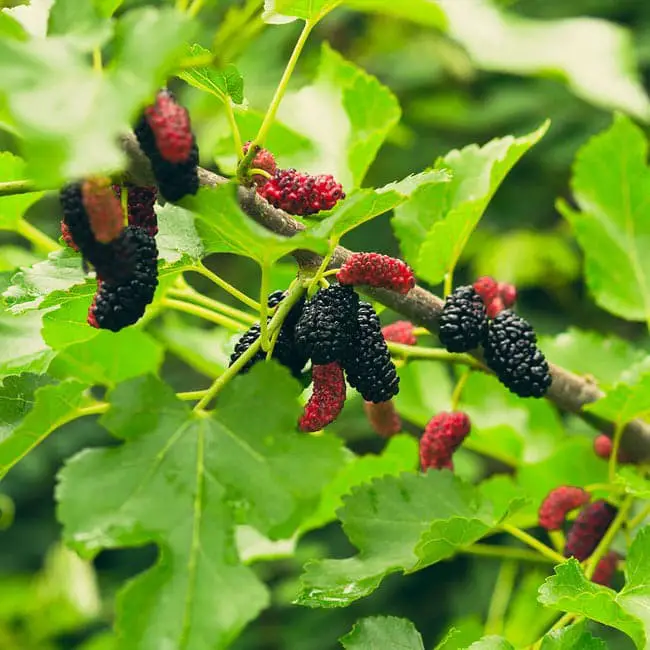
Mulberry trees, native to temperate regions worldwide, boast a rich diversity of species. The most widely recognized variety is the white mulberry (Morus alba), hailing from China. Meanwhile, the red mulberry (Morus rubra) and black mulberry (Morus nigra) are notable for their origins in eastern North America and western Asia, respectively.
Mulberry trees have earned a reputation for their succulent fruit, which is enjoyed fresh or used to craft an array of sweet treats – from pies to jams.
The fruit also finds its way into wine and liquor production. Additionally, the leaves of the mulberry tree play a crucial role in supporting the silkworms that produce silk thread.
Olive trees.

Olive trees, a type of fruit tree, produce olives, which are the fruit of the olive tree native to the Mediterranean Basin. The tree’s impressive stature reaches 20-30 feet in height, with a remarkable lifespan of several thousand years. The olive, a small oval-shaped fruit, grows on the tree and is harvested either green or black depending on the stage of ripeness. Green olives are unripe, possessing a sour-bitter taste, whereas ripe black olives have a milder flavor.
Olive trees thrive in warm climates globally, such as Spain, Italy, Greece, Turkey, and Morocco. In the United States, California is a significant producer. To flourish, olive trees require full sunlight and well-drained soil; they are also drought-tolerant and capable of withstanding cold temperatures.
Orange trees.
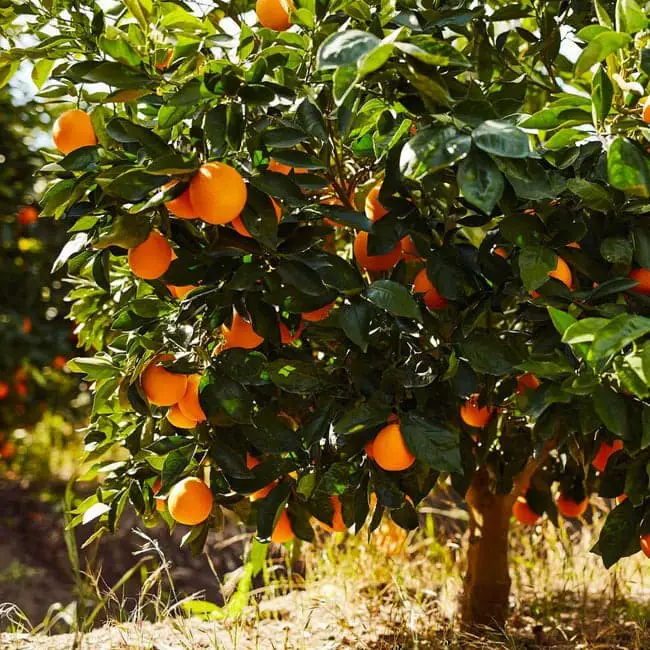
Orange trees, members of the Rutaceae family, produce oranges as their fruit. Specifically, Citrus × sinensis is the citrus species that yields this iconic fruit. This evergreen tree boasts alternately arranged leaves with toothed margins, and its white flowers appear either singularly or in clusters. The star of the show, however, is the orange itself – a fruit that has captivated cultures worldwide.
The journey of the orange tree began in Southeast Asia, where it’s believed to have been first domesticated in China or India. What’s fascinating is that this hybrid species originated from a natural cross-pollination between pomelo (Citrus maxima) and mandarin (Citrus reticulata). While its exact origin remains unknown, it’s clear that the orange tree has come a long way to become a staple in many cuisines.
Papaya trees.

Papaya trees are a type of tropical plant that can reach impressive heights of up to 20 feet. Characterized by their short and stout trunks, these plants boast large leaves that grow spirally around the stem. The fruit produced by papaya trees is highly versatile and often consumed fresh or used in various culinary applications such as juices, jams, and more.
Native to Mexico and Central America, papaya trees have spread to many tropical regions worldwide.
To thrive, these plants require warm temperatures and an abundance of sunlight, making them ideal for growth in greenhouses or sunny patios in cooler climates where outdoor cultivation may be challenging.
Peach trees.
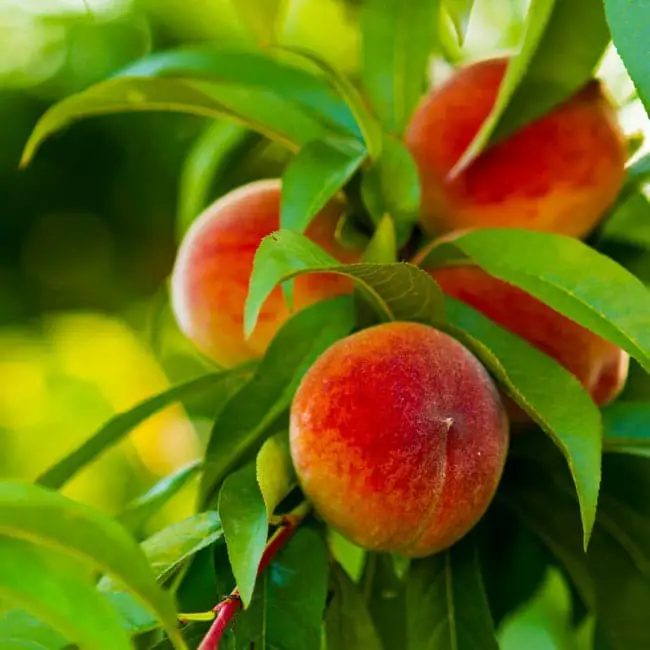
Peach trees, a member of the Prunus persica species, are a staple in many fruit-loving communities. Native to China, these trees belong to the esteemed rose family. As you might expect, there’s more to peach trees than meets the eye – or rather, more than can be seen at first glance.
While different types of peach trees do exist, they all share a few key characteristics. One notable trait is the vibrant pink or white hue of their flowers.
But what’s perhaps most striking is the fruit itself, which ripens to a brilliant yellow, pink, or red, depending on the specific tree variety.
Pear trees.

Pear trees, native to Europe, Asia, and North America, with ancient roots tracing back to China, produce the delectable pear fruit. As deciduous trees, they can reach impressive heights of up to 20 meters tall, their leafy canopy a striking feature. The leaves themselves are alternate, simple, and ovate in shape, while the showy flowers boast five petals and a radiant white hue.
But the pièce de résistance is, of course, the pear fruit itself – typically yellow, green, or brown in color, with an oval or spherical shape and a smooth exterior. Pears are not only a treat for the taste buds but also an excellent source of dietary fiber and vitamin C.
Pecan trees.
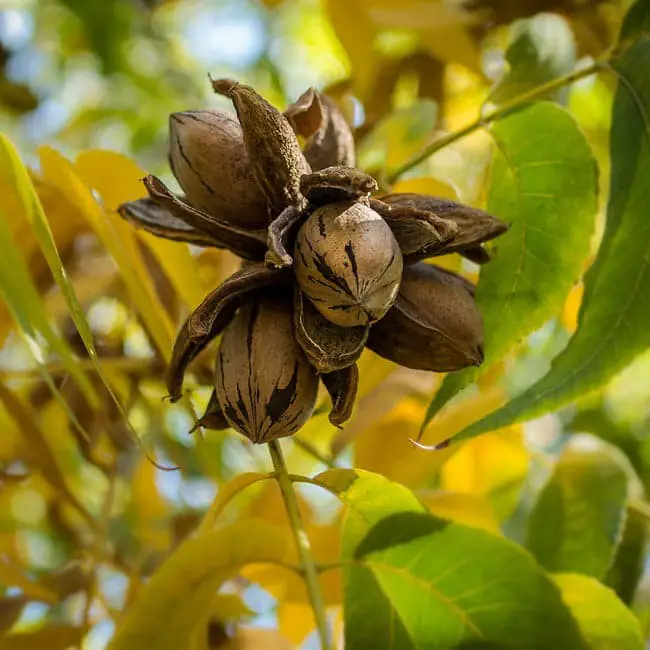
Pecan trees, native to North America, can reach heights of up to 40 feet and boast dark green leaves that encase edible nuts within a hard shell. This deciduous tree is commercially grown across the United States, contributing significantly to the country’s agricultural industry. In fact, the U. S. pecan crop was valued at $687 million in 2016. While the majority of pecans are consumed domestically, a small percentage is exported globally.
Pecans themselves are a popular ingredient in baking, offering a sweet, buttery flavor that pairs well with other ingredients. They’re commonly used in pies, cakes, cookies, and other sweet treats.
Persimmon trees.

The Persimmon tree holds a revered position in Japan, where it has been cultivated for centuries to earn the distinction of national tree. Botanically known as Diospyros kaki, this tree also goes by the names Oriental Persimmon or Japanese Persimmon. The fruit that grows on the Persimmon tree is simply referred to as a persimmon, and it presents itself in various shapes and sizes, ranging from a small plum to a large grapefruit.
When ripe, the skin of the fruit is characterized by its thinness and smoothness, with hues of yellow, orange, or red. The flesh of the persimmon is renowned for its sweetness, accompanied by an abundance of seeds. Japan boasts two primary varieties of Persimmon trees: the astringent and non-astringent types. The astringent type is notable for containing tannins, which impart a bitter taste to the fruit.
In contrast, the non-astringent variety does not contain these compounds, resulting in a sweeter tasting persimmon.
Plum trees.
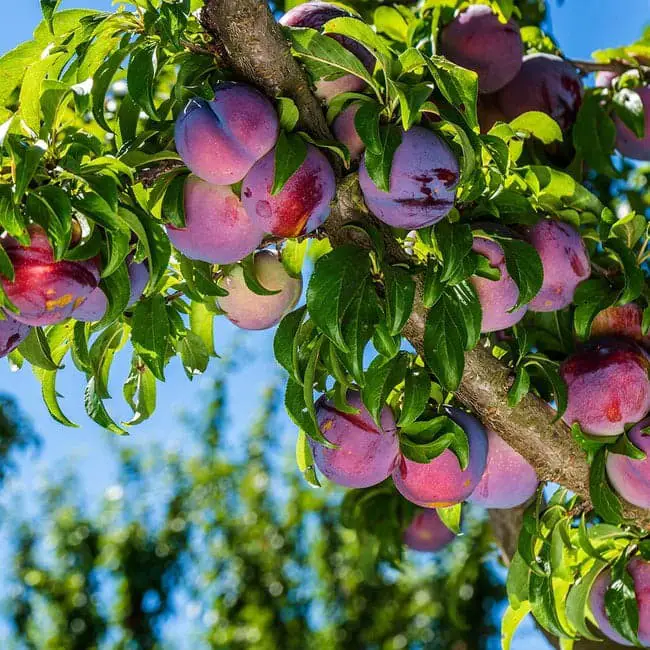
Plum trees, a type of deciduous tree, thrive by producing plums as their crowning achievement. On average, these trees reach heights between 15-20 feet tall and have an expected lifespan of around two decades. Native to Europe, Asia, and select regions in Africa, plum trees have adapted to various climates over time.
With numerous varieties to explore, including the American, European, and Japanese plum tree types, as well as classifications based on fruit type – such as prune plums, fresh plums, and ornamental plums – the world of plum trees is both diverse and intriguing.
Plum trees typically bloom during the spring season, with flowers ranging in hue from pure white to delicate pink. The fruits themselves mature in late summer or early fall, making them a bountiful harvest.
Notably, plums are an excellent source of essential vitamins and minerals like vitamin C and potassium, providing numerous health benefits when consumed fresh, canned, dried, or used in jams, jellies, and preserves.
Pomegranate trees.
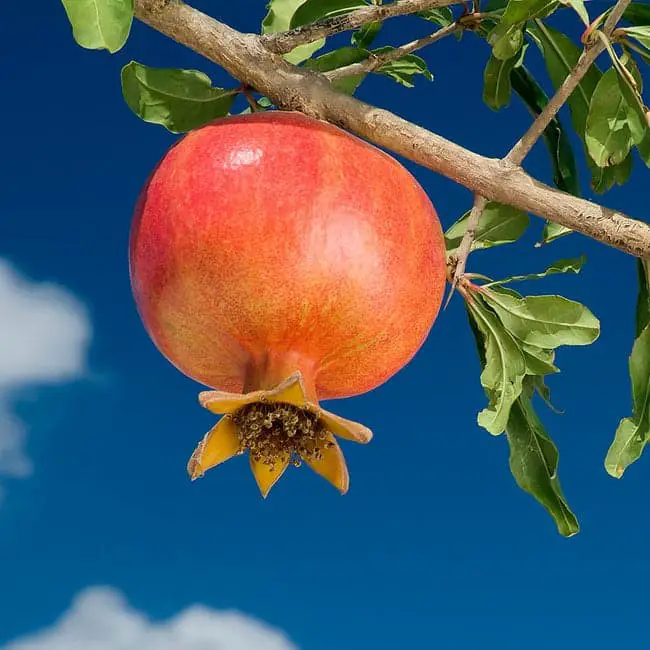
Pomegranate trees, characterized by their deciduous nature, typically grow between five to eight meters tall. Their dense foliage consists of dark green leaves with a leathery texture, while their branches feature sharp thorns that provide protection from predators. Pomegranates are widely cultivated in tropical and subtropical regions, boasting popularity across various cuisines.
Originating from the region between the Himalayas and the Persian Gulf, pomegranate trees have been a staple crop since ancient times. References to this fruit can be found in biblical texts and Homer’s Odyssey. The Arabs introduced pomegranates to Europe, while the Spanish brought them to the Americas.
As one of the oldest fruits known to humanity, pomegrante trees come in many varieties. The ‘Wonderful’ variety, first cultivated in California, is particularly well-known.
Other popular types include ‘Grenada’, ‘Crimson Star’, and ‘Eversweet’.
Pomegranates are a nutritious fruit, rich in vitamins C and K. They also contain antioxidants that can help protect cells from damage. With numerous health benefits, pomegranates are often consumed as a healthy snack.
Pomelo trees.

Pomelo trees, native to Southeast Asia, boast a scientific name of Citrus maxima and share a familial connection with grapefruit. This citrus fruit tree is notable for producing the largest of all citrus fruits, with some varieties reaching weights of up to ten pounds. The Pomelo’s thick skin often exhibits a range of colors, from yellow to green. When it comes to the fruit’s flesh, consumers can expect a delightful pink or red hue that’s simply bursting with juice.
Fresh consumption and juice production are among the most popular ways to enjoy this luscious citrus treat.
Quince Trees.

Quinces are a type of deciduous fruit trees that share a common ancestry with apples and pears. The fruits they produce, which resemble pears in shape, have a distinctively tart taste. In culinary circles, quince fruits are often used to make pies, jams, and jellies due to their unique flavor profile.
Quinces have a long history that dates back to Asia and the Middle East, where they are native. The Romans played a significant role in introducing quince trees to Europe.
Today, quinces thrive in warm climates around the world.
Rambutan trees.
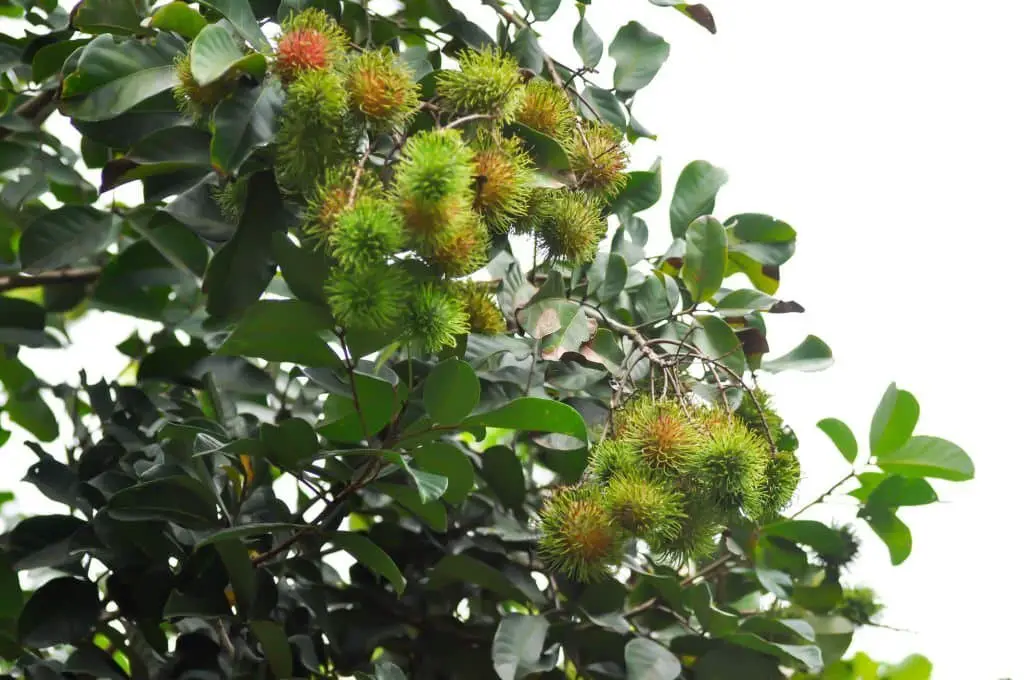
Rambutan trees, originating from Southeast Asia, thrive in tropical climates. Reaching heights of up to 20 meters, these trees are distinguished by their dark-green, glossy leaves. A notable feature of the Rambutan tree is its fruit, which boasts an oval shape and a hairy, red or yellow skin that sets it apart. The flesh of the fruit itself is white and houses a significant seed, adding to the fruit’s unique characteristics.
Sapodilla trees.

Sapodillas, native to the Yucatan Peninsula and parts of Central America, are a staple in tropical regions. Their fruit, with its distinctive brown or black skin and white fleshy interior, is enjoyed fresh or incorporated into sweet treats. The tree itself belongs to the Sapotaceae family, scientifically known as Manilkara Zapota, and can grow up to 30 meters tall, with trunks reaching diameters of up to one meter.
This tropical dweller requires copious rainfall and is typically propagated through seed, air layering, or grafting. As a sought-after tree in the tropics, sapodillas are cultivated across countries such as Thailand, India, Pakistan, Sri Lanka, Malaysia, Indonesia, and the Philippines, with their fruit being a popular ingredient in desserts, often used to create creamy shakes and ice cream.
Soursop trees.
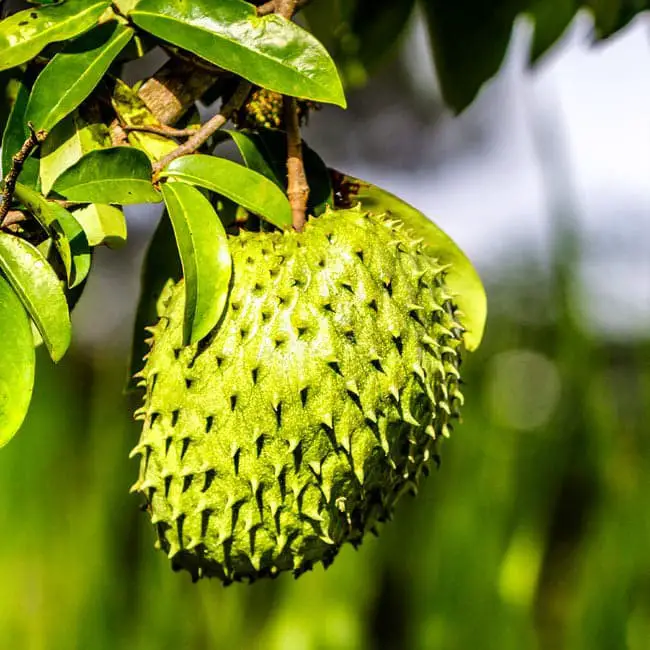
In the realm of tropical evergreens, one species stands out – the soursop tree (family Annonaceae). Its native habitat spans Central America, the Caribbean, and parts of South America. This majestic tree can reach heights of up to 20 feet, with dark green leaves serving as a canopy. Aromatic white flowers adorn its branches, emitting a strong fragrance that’s hard to miss. The fruit itself is quite impressive – large, green on the outside, and boasting white flesh within.
The soursop tree is also known by the Spanish moniker guanabana. Beyond its stunning appearance, this tree has gained significance for its versatile fruit. It’s used to craft a range of sweet treats like juices, ice creams, and sherbets. Moreover, the fruit holds medicinal properties, with traditional remedies employing it to treat various conditions, including cancer, fever, and malaria.
Sweet chestnut trees.

The sweet chestnut tree is a majestic deciduous giant that can reach impressive heights of up to 40 meters tall. Its broad canopy spreads out wide, providing ample shade and shelter. The leaves, a deep green hue with deeply lobed edges, are a striking feature of this tree. Small, yellow-green flowers bloom in clusters of 20-30, while the fruit takes the form of spiky, brown nuts that ripen in late autumn.
Native to southern Europe and Asia Minor, sweet chestnut trees have been successfully introduced to other regions, including North America and Australasia. Today, they are widely cultivated for their ornamental value and timber, making them a popular choice among landscapers and tree enthusiasts alike.
Nectarine Trees.
Nectarine trees, a type of stone fruit tree, are characterized by their production of nectarines – a fruit that shares many similarities with peaches. A key distinguishing feature of the nectarine is its smooth skin, devoid of the fuzz found on peach skin. From a culinary perspective and in terms of nutritional value, both fruits are quite similar. The evolutionary history of nectarine trees is closely tied to that of peach trees.
It’s believed that they share a common ancestor, with early cultivation efforts taking place in China and Persia. The Romans introduced nectarine trees to Europe, while the first recorded planting in America occurred in Massachusetts in 1799.
Columnar Fruit Trees.
Columnar fruit trees are a unique type of tree that is cultivated to grow in a columnar or cylindrical shape. This distinct feature makes them popular for ornamental purposes in gardens, parks, and even commercial orchards. One notable characteristic of these trees is their grafting onto specifically bred rootstocks designed to produce this specific shape. The most commonly used rootstocks are dwarfing varieties, which allow the tree to maintain its columnar form while still producing fruit.
FAQs about fruit trees
What is the most common fruit tree?
Apple trees, specifically the most widespread variety, are a staple in many fruit orchards worldwide. Known for their sweetness and impressive nutritional profile, apples have earned themselves a spot as one of the most beloved fruits globally. Their vast cultivation range spans across multiple continents, including North America, Europe, Asia, and Africa, making them a ubiquitous feature in many regional landscapes.
What is the easiest fruit tree to grow?
Intriguingly, bananas are scientifically classified as berries, defying their everyday fruit categorization. As a globally sought-after fruit, bananas have earned a reputation for being relatively simple to cultivate. Moreover, they’re an excellent source of essential nutrients like dietary potassium, vitamin C, and fiber-rich goodness. Additionally, bananas provide a range of B-complex vitamins.
Enjoyed in various forms – fresh, cooked, or dried – this versatile fruit is often incorporated into sweet treats.
What is the fastest growing fruit tree?
Grapefruit trees have emerged as one of the most rapidly expanding types of fruit trees, boasting an astonishing growth rate of up to 24 inches within just a solitary year. Originating from Asia, these trees thrive in warm climates, where their unique characteristics allow them to flourish.
What fruits grow well together?
When it comes to growing fruit, one of the most exciting aspects is the ability to combine different varieties to suit your taste or available space. But which fruits pair well together? Here are some surprising and effective combinations to try in your garden or on your windowsill.
For a classic summer duo, look no further than peaches and nectarines. These stone fruits thrive in warm weather and require full sun to produce sweet, juicy fruit that’s perfect for snacking or baking.
If you’re looking to bring some tropical flair to your garden, mangoes and papayas are an unbeatable team. Both fast-growing fruits enjoy similar growing conditions: hot weather, high humidity, and plenty of sunshine. Together, they’ll create a lush canopy that’s sure to draw in bees and butterflies.
For a more temperate combination, try pairing pears and apples. As part of the same rose family, these fruits often grow well together in similar climates.
Plus, their sweet, crisp flesh makes for a delicious pie filling or snack.
What fruit trees produce the first year?
When it comes to determining when your fruit tree will start producing fruit, the type of tree you have plays a significant role. Some species, such as apple and pear trees, are known to yield fruit within the first year after planting. In contrast, others like peach and plum trees typically require an additional 12 months before they begin producing fruit.
Which fruit takes the shortest time to grow?
Bananas stand out from the crowd as one of the fastest-growing fruits, with a remarkably short maturation period. In fact, it’s possible to harvest them just six to seven months after planting. This rapid growth makes bananas an attractive option for farmers seeking a swift return on their investment, far outpacing other popular fruits like apples and oranges that can take up to two years to reach maturity.
The speed at which bananas grow has made them a staple choice for growers looking for a quick and reliable crop.
Conclusion
Ultimately, the plethora of fruit tree options available presents a fascinating challenge. Each variety boasts its own distinct flavor profile and set of benefits. As you deliberate over which fruit tree to bring into your garden, it’s essential to take into account the nuances of your local climate and soil composition. By conducting some preliminary research, you’ll be well-equipped to find the ideal fruit tree that harmonizes with your surroundings and brings joy to your table.
Related Posts
Discovering the incredible world of online plant nurseries, one variety at a time. From the majestic apple trees to the evergreen marvels, there’s an astonishing array of species to explore and learn about. But what makes these plants so special? Perhaps it’s the unique skillset required to care for them, or maybe it’s the profound impact they have on our surroundings. Whatever the reason, one thing is certain: trees play a vital role in property value and overall well-being.
Whether you’re looking to boost your home’s appeal with a lush canopy or remove unwanted foliage, understanding the art of tree care is essential. For those passionate about horticulture, becoming an arborist can be a fulfilling career path. And did you know that certain plants, like the Lady Palm and organic blueberry bushes, can thrive in even the most unexpected environments? The possibilities are endless when it comes to cultivating life outdoors.






